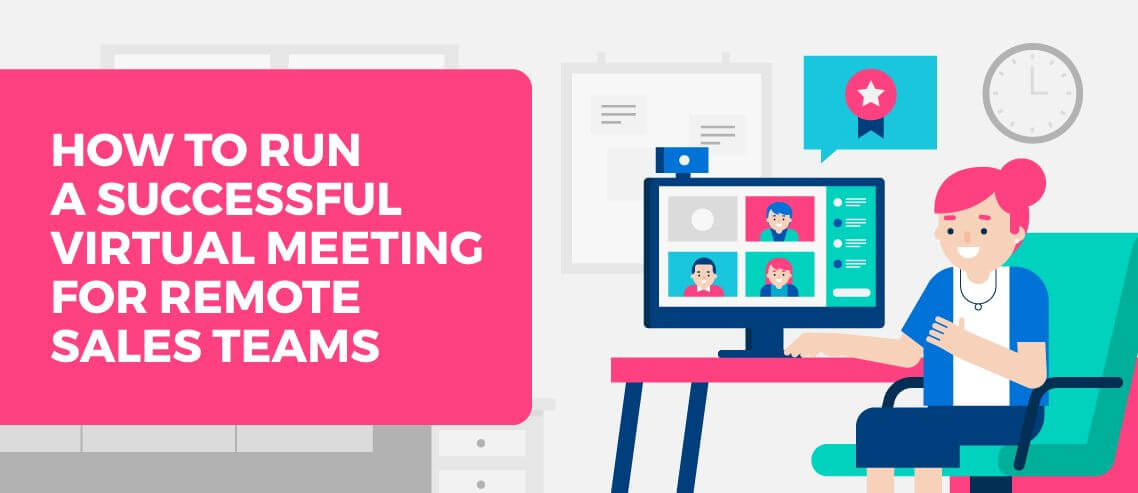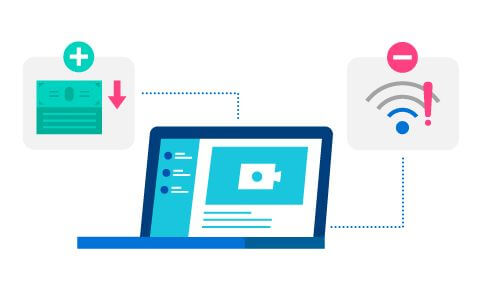How to Run a Successful Virtual Meeting For Remote Sales Teams

Contents
Whereas virtual meetings were once seen as a last resort, today they have become the go-to option for many sales teams.
There’s no sign of things changing anytime soon. In fact, recent research shows us that sales of web conferencing software have increased by 500% since the beginning of the coronavirus pandemic.
Clearly, virtual meetings are very different to regular office-based meetings. They require a level of planning and finesse to make them effective and ensure that the lack of face-to-face contact doesn’t prevent you from achieving your goals.
With that in mind, here’s how to run a successful virtual meeting for your remote sales team:
What Is a Virtual Meeting?
Broadly speaking, a virtual meeting is simply any meeting that doesn’t happen in person. The wonders of modern technology make it possible to collaborate effectively with colleagues on the other side of the world. All you need is a decent internet connection.
There are four main types of virtual meeting:
- Teleconferencing — Audio-only virtual meetings that typically involve multiple people dialing in using a specific phone number and passcode.
- Video conferencing — Audio and video meetings. Similar to teleconferences, they rely on people logging into an interface that enables participants to see and hear one another.
- Web conferencing — Audio and video meetings that extend the reach of traditional video conferencing by allowing participants to engage and collaborate in additional ways, such as by distributing documents and sharing screens.
- Webinar — A one-to-many video conferencing format that provides a one-way platform for presenters or educators to pass information along to a group of people.
What Are the Advantages and Disadvantages of Virtual Meetings?
While virtual meetings have some drawbacks compared to in-person meetings, they offer some major advantages too. Let’s take a look at the pros and cons of virtual meetings here:

Pros
- Reduced expenses. If you’re not holding face-to-face meetings, you don’t need to hire a meeting room. In fact, if your whole sales team is remote, you might not need an office at all, which equates to big savings.
- Greater participation. People can attend and get involved regardless of where they’re based. And because everyone is attending remotely, the meeting won’t be dominated by people who are in the office.
- No travel. Your sales team can attend meetings in real time without having to endure the commute.
Cons
- Missing body language and social cues. This is a big one. It can be harder to discern what people really mean or how they feel when you’re not in the same room.
- Additional software expenses. If virtual meetings are a key part of your workflow, you likely won’t be able to get by on free (or freemium) product tiers.
- Weak internet connections can affect meeting quality. If someone has bad Wi-Fi, they can’t contribute to the meeting. In fact, they might not be able to attend at all.
Steps to Planning a Virtual Meeting
Any meeting requires preparation. But that’s especially true of virtual meetings; the remote element means you need to go the extra mile to make everyone feel involved and engaged. Here’s how to get it right:
1. Book a time that works for everyone
When your team is remote, there’s always the potential that they’ll be based across multiple time zones. Clearly, you’ll need to take this into account when booking your meeting.
Also, ensure you avoid schedule conflicts. Sales reps work hard on building trust with their prospects, so if they’re expecting an important call or email, that needs to be their priority.
Finally, be strict with the invite list. Does everyone need to be there? If it’s not relevant to your BDRs, don’t waste their time – keep it to SDRs and sales leaders.
2. Share the agenda ahead of time
Setting clear expectations and sharing important documents ahead of time makes it easier for everyone to prepare. In turn, that ensures your meeting will be more efficient, reducing the amount of time you have to spend on basic explanations and other preamble.
3. Pick the right virtual meeting tool
Different conferencing tools have different strengths and weaknesses. For instance, a quarterly sales meeting might work best as a web conference, particularly if multiple people need to speak and share their screens. On the other hand, earnings calls – which aren’t particularly visual – might be best suited to teleconferencing.
Whichever tool you choose, be sure to include links, dial-in numbers, and passcodes in the meeting invite.
4. Rehearse if needed
For more challenging meetings – such as when you’re presenting to the board or a potential client – don’t just assume it’ll be alright on the night. Instead, you should absolutely run a dress rehearsal.
Where multiple people are required to speak and contribute to slide decks, a run-through can help iron out any weak points, avoid repetition, and ensure your content is on point.
How to Run a Successful Virtual Meeting
Getting the planning right is the first part of the battle; next it’s time to execute. Your preparation should help you steer clear of any major glitches, but there are still plenty of things that can go wrong. Here’s how to get it right:
1. Test your technology ahead of the meeting

Don’t leave the success of your meeting to chance. Test all the elements that might let you down:
- Make sure your video camera and microphone are working as expected.
- Check your Wi-Fi connection by running a speed test.
- Make sure you can share your screen – and that you have all your key documents and slides to hand
- Ensure you can see your meeting notes when you’re in presentation mode.
- Test the sound quality in the space from which you’ll be hosting the meeting to make sure it’s not too echoey and that there’s no off-putting background noise.
As a final step, it pays to assume that something will go wrong. Backup your documents, print out your notes in advance, and have another virtual meeting tool in your pocket in case your first choice goes down.
2. Choose video when possible
Where virtual sales meetings are concerned, video is almost always preferable to audio-only meetings.
You risk losing a lot of context and nuance when communicating over the phone or through text. By contrast, video activates more senses, makes attendees feel more engaged, and generally feels more professional.
Additionally, with video, there’s less chance of people speaking over one another because it’s easy to see when someone’s finished making their point or paused to take a sip of water.
What’s more, it’s obvious when someone’s having technical issues with video, which means you can adjust accordingly.
3. Focus on engagement
A sales meeting isn’t about reeling off every one of your talking points as efficiently as possible.
For it to be effective, those points need to sink in – and that just won’t happen if your team doesn’t feel engaged.
To drive engagement, make your sales meeting a two-way conversation rather than a one-way presentation. Ask regular, open-ended questions to encourage back and forth between attendees; ask different people to share their screens; and consider segmenting larger sessions into smaller breakout rooms to make collaboration more effective.
4. Make good use of everyone’s time
Remember sales reps time is extremely valuable. It’s your job to ensure that your meeting starts and ends when it’s supposed to.
Don’t allow side conversations to dominate the session – if an issue can’t be resolved quickly and efficiently, take it off-line.
Finally, consider breaking up your agenda into multiple sections. Allow people in different roles to join later or leave earlier if a given section isn’t relevant to them. Don’t be offended – they’ve got other work to do.
What To Do Post-Meeting
The job of running an effective virtual sales meeting doesn’t finish the second everyone hangs up. You still have some important post-meeting tasks to carry out. For instance:
- Share a recording of the meeting for anyone who was unable to attend
- Type up the meeting notes, format them into a logical order, and share them
- Assign follow-up actions through your chosen product management tool
- Ensure anyone who’s been assigned an action understands what’s expected of them
- File all associated documents in the relevant place so they can be accessed by everyone
- Where relevant, schedule the follow-up meeting

Investing in the Right Tools
Getting your virtual meeting tech stack in order allows you to run more engaging, collaborative, and efficient meetings. So while that software might cost you a little money, it’ll likely save you a whole lot more by making your virtual meetings more effective and actionable.
There are hundreds, or perhaps thousands, of different tools you could choose. But as a starting point, consider the following to make some of your virtual meeting tasks run more smoothly:
- File sharing: Dropbox
- Project management: Asana
- Video conferencing: Zoom
- Instant messaging: Slack
- Meeting scheduling: Calendly
- Password management: LastPass
Conclusion
Not long ago, the thought of running a high-performing, fully remote sales team would have caused the average sales leader to break out in a cold sweat.
But now that every sales team has been forced to operate remotely for an extended period, it’s clear that virtual working doesn’t have to be a barrier to success – provided you get your sales meetings right.
By preparing effectively, you can make your virtual meetings engaging, impactful, and actionable, without forcing your sales team to come together in a single space. It’s the best of both worlds.





